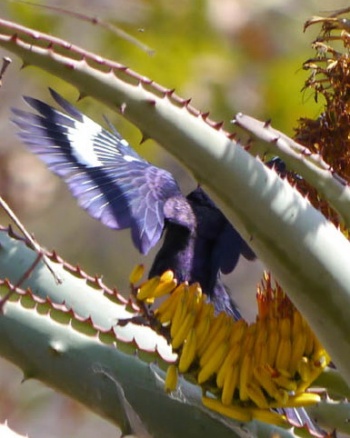- Rhinopomastus cyanomelas
Identification
26–30 cm
- Black plumage which in perfect light looks purple glossed
- White spotted primaries form a white bar but without an additional white spot (contra some Wood Hoopoes)
- Black strongly decurved bill
- Black feet
Similar species
Wood Hoopoes generally have less decurved bill; notice that in some of the red billed species, the young have black bill and may be confused with the black-billed Common Scimitarbill.
Distribution
Southern half of Africa
Western Africa: Democratic Republic of Congo and Angola
Eastern Africa: Somalia, Kenya, Uganda, Rwanda, Burundi, Tanzania, Zanzibar, Zambia, Mozambique and Malawi
Southern Africa: Namibia, Botswana, Zimbabwe, South Africa, KwaZulu-Natal and eSwatini
Taxonomy
Subspecies
Rhinopomastus cyanomelas is polytypic; there are two subspecies:[1]
- R. c. cyanomelas
- Angola and Namibia to northern South Africa
- R. c. schalowi
- Somalia to Zambia and KwaZulu-Natal (eastern South Africa)
Habitat
Savanna, evergreen woodland, thorn-scrub to 2,000m.
Behaviour
Diet
The diet includes insect larvae, insects, spiders, buds, nectar and fruit.
Breeding
They nest in a tree hole. The 2-4 white eggs are incubated for 17–18 days. The young fledge about 24 days later.
References
- Clements, J. F., T. S. Schulenberg, M. J. Iliff, T. A. Fredericks, J. A. Gerbracht, D. Lepage, S. M. Billerman, B. L. Sullivan, and C. L. Wood. 2022. The eBird/Clements checklist of Birds of the World: v2022. Downloaded from https://www.birds.cornell.edu/clementschecklist/download/
- Answers.com
- Sinclair et al. 2002. Birds of Southern Africa. Princeton Field Guides, Princeton, New Jersey, USA. ISBN 0-691-09682-1
Recommended Citation
- BirdForum Opus contributors. (2024) Common Scimitarbill. In: BirdForum, the forum for wild birds and birding. Retrieved 28 April 2024 from https://www.birdforum.net/opus/Common_Scimitarbill
External Links
GSearch checked for 2020 platform.1





